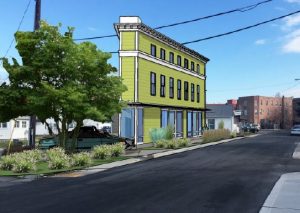
BERLIN – A mixed use project proposed by Habitat for Humanity of Worcester County is set to move forward after receiving planning commission approval.
On Wednesday, the Berlin Planning Commission voted unanimously to approve Habitat for Humanity’s plan to replace an old home with a new building featuring retail and apartments at 21 Jefferson St.
“This is how the town should grow — from within,” planning commission member Ron Cascio said.
Habitat for Humanity plans to tear down the early 20th Century home on the site and erect a two-story building. The new structure would feature retail space on the ground floor and apartments on the second floor. The organization would sell the apartments but would lease out the retail space, providing Habitat for Humanity with a steady stream of income.
While commission members expressed support for the concept of a mixed-use structure reminiscent of New York’s Flatiron Building, they questioned its layout on the site. They agreed that the building would benefit from sitting closer to the street than proposed.
“I’m not sure why we’re not maximizing the space,” commission member Pete Cosby said. “To have it set back off Jefferson Street, what a waste of space.”
David Quillin, Habitat for Humanity’s architect, explained that to put the building any closer to the street he would have to seek a variance from the town’s board of zoning appeals. That, however, would take additional time, and the non-profit is at the end of the 90-day study period it was granted by the property’s current owner. Habitat officials received approval from the town’s historic district commission to tear down the home that’s currently on the site in March.
“Habitat needs to know they’d be able to get approvals before purchasing the lot,” Quillin said.
Cosby stressed that creating a slightly larger building that sat five feet closer to the street, like most buildings do downtown, would be the best option for the site.
“This is such a trendsetter for the street,” he said. “I don’t want to see it become less than what it should be,” Cosby said.
Cascio agreed.
“That extra five feet would do a great deal in making it more usable,” he said. He also suggested the medium sized tree shown on the project’s rendering be replaced with a large tree.
Cosby said the building was the right idea but would benefit from sitting closer to the street.
“It would be a tragedy to do this building this way,” he said.
Lauren Bunting of Habitat for Humanity’s board of directors said the organization would support doing just as the commission suggested but was working on a strict timeline and in need of an immediate approval. Andrea Bowland, executive director of the organization, agreed.
“We want to work with everybody,” she said.
The commission agreed to approve the project with the condition that Habitat for Humanity seek a reduced setback from the board of zoning appeals.

